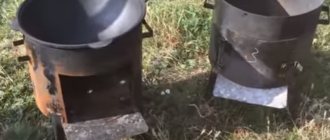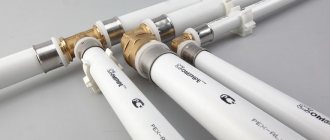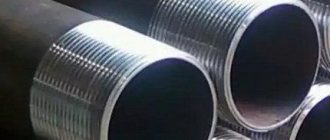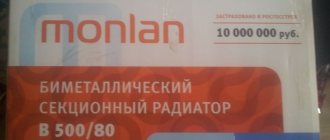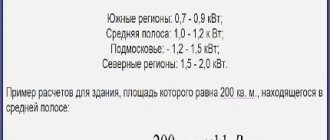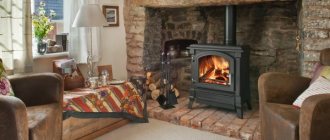Electric sauna stove: how to choose?
But it won’t be a matter of choice, you just need to get a sufficient understanding of what a sauna stove is, what types the market offers, and how to take into account the features of an existing steam room when purchasing.
We will try to provide comprehensive information on each of the points. And we’ll start, perhaps, by answering the question about what types of electric stoves there are:
By voltage: 220V or 380 volts
The voltage in a regular household electrical network is 220 volts. Therefore, most buyers are interested in their furnace operating from such a network. This would save them additional hassle and expense.
However, in practice, the voltage consumed is directly dependent on the power of the purchased unit. And the power, in turn, depends on the volume of the heated room .
It follows from this that the owner of a large family or family-guest sauna does not have to count on cutting costs - a large stove will need a 380-volt network. IMPORTANT! Typically, sauna stoves that consume 220 volts have a power of no more than 7 kW.
This is enough for a small and even medium-sized steam room. Electric heater SAWO MINI MN-23NB-Z. Photo by SAWO
You can bring 380 volts into a house or apartment - it’s not particularly difficult, you just need to take three instead of one phase. Difficulties arise with permits and with replacing wiring (it must be thicker than usual). Well, don’t forget that you will have to pay more for electricity bills, but this does not depend on the network itself, but on energy consumption.
By the way, you can easily install a three-phase 380 volt network in private homes - not everyone knows, but this issue is resolved at the request of the consumer.
Let's name several models of each subspecies:
Electric sauna heaters 220 volts - Helo CUP 45 ST, Sawo Mini MN-23 NB-Z, Harvia Vega Compact BC 23, Tylo Compact 2/4, Polytech-M PEN-2m.
Electric sauna heaters 380 volts - EOS 34 A, Harvia Virta HL 90, Tylo SD 20, Helo Seidankivi Seita 1052, Polytech "Christina" with evaporator ENU-18i.
Keep in mind! In the characteristics of some furnaces there is a mention of the possibility of connecting to both single-phase and three-phase networks - “220/380”.
Electric sauna stove Harvia Trendi KIP (220v and 380v)
With and without a steam generator
Another interesting point: do you need a stove with a steam generator in a sauna? After all, a sauna is called a “dry air bath” for a reason - there is little steam in it, the main “ingredient” is dry heat, which makes a person sweat (and convection is responsible for evaporation). How will he sweat if the humidity in the bathhouse increases?
Do you know, for example, why in Japan at 30 degrees the heat is considered unbearable, but in continental Asia even at 50 degrees people continue to calmly go to work? Because high humidity does not allow sweat to evaporate from the surface of the body, and it does not cool it (continental air is much drier than island air). The result is overheating, heart problems and other related ones.
IMPORTANT! You need to be careful with the steam generator in the sauna. Lower the temperature if you want more steam. And for an ordinary sauna, the steam produced by a regular heater, which is available in all electric models, is quite suitable.
However, sometimes a steam generator is necessary. For example, when we are talking about a heater that can operate in the “sauna” and “Russian bath” modes. Of course, it will be a surrogate, but it will be fast. The heater will almost instantly heat the bath to 60 degrees, and the steam generator will produce (if it can) fine steam.
BY THE WAY! Couples are different. There is a low-temperature one - you usually see it above pots and kettles. It is white and thick, and heavy on the body. There is superheated steam - it is almost invisible, it is light, and this is what your steam generator should be able to produce.
Steam generators are also different: built-in and separate. Here are some models.
Steam generator Helo HNS 34 T1
Separate:
- Sawo STP-90-C1/3 SST,
- Harvia HELIX HGX 2,
- Helo HNS 34 T1,
- Tylo Steam 2/4/6 VB,
- HygroMatik CompactLine C06-CDS,
- Sturm Etna 3 Pietra,
- EOS SteamTec Classic.
Built-in : all models with the word Combi in the name.
Electric stove for mini-sauna
A mini-sauna is a very small room (from 1.5 cubic meters), designed for one or two people steaming at the same time. Recently, it has become fashionable to arrange these right in city apartments.
Pleasant things are combined with useful things. A mini-sauna does not consume much electricity, and you can even make it yourself. The main thing is to take good care of thermal insulation.
What kind of stove can be used for a mini-sauna? Of course, also tiny. By the way, sometimes manufacturers put the word Mini or Compact in the name of such products. Here are examples of some models that you will find on the market:
Sawo - Mini and Mini-X series (see photo above). Harvia - Vega Compact, Delta, etc.

Harvia Delta D23 oven. Harvia Photos
By place of production: Finnish electric furnaces and all others
Who is considered the best manufacturer of sauna stoves? Of course, those who understand the intricacies of this bathhouse better than others. And in this regard, the Finns have practically no competitors - this is their national pride, which they are happy to export to the whole world. But exporting is always expensive.
Here are the names of companies that are popular in the market:
- Finland - Helo, Sawo, Harvia (a separate article is devoted to electric heaters from this manufacturer), Narvi.
- Sweden - Tylo.
- Germany - EOS.
- Russia - Inzhkomtsentr, Polytech, fuel and energy complex.
According to the material of electric heaters: tape and tubular
Well, of course, the ovens themselves are not belt or tubular. We are talking only about the design of the heating elements, which can be either in the form of tubes or in the form of a ceramic tape. Tubular shells are usually made of metal.
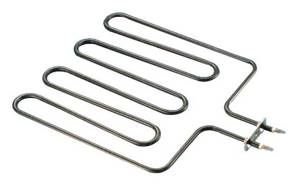
Tubular heater
IMPORTANT! Tubular electric heaters are quite fragile and easily fail. They can be damaged by stones that are placed too tightly (when heated, the stone expands), or simply by a random movement that bends the heating element at the base. See the article about the correct placement of stones in an electric heater.
Today, most electric heaters are equipped with tubular elements. The reason may also be a reduction in cost. But this is not the best option for the consumer. They are not as economical as tape ones. The latter also burn less oxygen!
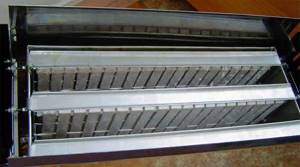
Electric sauna stove, strip. Photo source
On a note! When calculating power, take into account that strip elements with equal power heat one and a half times the volume.
Useful video
Also watch a video about choosing electric stoves for a sauna from different points of view:
Device and types
The electric furnace has a simple design consisting of a metal body, electric heaters and thermal insulation. The solid body is most often made of stainless steel. Inside it, a grate is installed on top of the electric heaters, which is completely filled with stones. The size and weight of these stones largely determines the rate of heating of the bath or sauna: the larger and heavier they are, the faster the room will warm up.
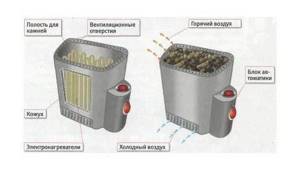
Electric furnace diagram
By design, furnaces can be open or closed. The devices of the first type are in greatest demand, as they not only warm up the bathhouse or sauna well, but also create good moist steam. For the body of such a furnace, nichrome wire is used, fixed in a ceramic heating base. Closed-type devices consist of a heat shield, heaters and a conductive element.
In addition to division by design, furnaces are divided by type of heater. They can be equipped with a tubular heating element or a strip heating element. The heating element is most often used, since its cost is lower than that of the second type of heater. Stones are placed on top of the tubular elements so that the room quickly heats up to the desired temperature.
Note! It is prohibited to turn on the oven without stones loaded into the mesh.
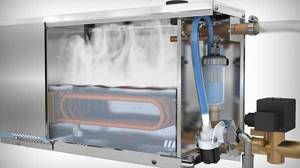
Heating element in an electric furnace
The tape heating element is a metal strip. Compared to heating elements, it consumes less electricity and has a larger heat exchange area. But stoves equipped with this heater are more expensive.
There are models that have stone cladding. Such stoves protect against excess thermal radiation and make the heat and atmosphere in the bathhouse or sauna softer.
Pros and cons of ovens
Electric ovens have a number of advantages. They are much smaller in size than brick structures, and also warm up a bathhouse or sauna faster. An electric stove does not require solid or liquid fuel, which means you don’t have to waste time buying it, storing it and throwing it into the firebox, or organizing a storage space. It can be controlled remotely using a remote control.
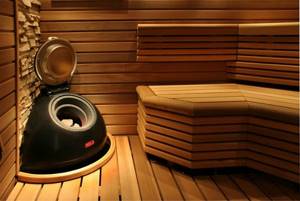
Original design of a small stove
Positive qualities of electric ovens:
- Heats up the room quickly;
- Retain heat in a bathhouse or sauna for a long time;
- They have compact dimensions (low-power models have dimensions of 50x50x50 cm);
- Quick and easy installation;
- There is no need to install a chimney to remove carbon monoxide;
- Easy maintenance and operation;
- They do not emit carbon monoxide.
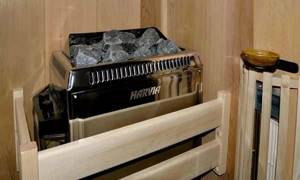
All control of the device comes down to setting the required heating temperature on the controller. To protect against accidental overheating, a fuse is built into the oven. A large number of models of different sizes, designs and power allow you to choose a device to suit any room and needs. Also, due to the fact that solid fuel, such as firewood, is not used, there is no ash or dust, which greatly simplifies the process of cleaning a bathhouse or sauna.
Since the device automatically controls the temperature, this helps to significantly save electricity costs. When the set temperature is reached, the oven switches to economy mode. If the temperature reaches the lower mark, then it starts working at full capacity again.
The disadvantages of electric heaters include the emission of a strong electromagnetic background. Therefore, when entering a sauna or bathhouse, it is better to turn it off for a while. It is not economical to use an electric oven for a long time. The thermal power of an electric device is lower compared to solid fuel and gas heaters.
Rating of electric sauna stoves
Well, we looked at a number of models based on various criteria. It would be a good idea to bring the information together to make it easier for the reader to make their choice. Therefore, we decided to invite users to take part in compiling a rating, this time of electric sauna stoves.
For our part, we have selected a list of the most popular manufacturers, because it is important to know who you can trust, and the parameters of the steam room and the needs of all consumers are different, it is not possible to take them all into account. But with our joint efforts we can easily help beginners with their choice.
Now is the time to move on to practical issues. Let's start with those that are asked by those sauna owners who have already decided to buy an electric heater. They need to know how to choose a stove with the right parameters.
Recommendations for installing an electric stove
A small electric furnace with a power of 4.5 kW is installed in a small steam room. Before starting work in the steam room, it is necessary to remove the wiring and provide fresh ventilation.
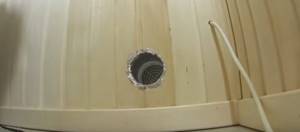
Ventilation needs to be taken care of in advance.
To carry out the work you need the simplest tool and some materials. You need to stock up on sheets for creating a screen and self-tapping screws, for installation of which you will need a screwdriver. To cut holes in the screen plates, you will have to use a jigsaw. To connect the cable to the terminals, you need a Phillips screwdriver.
Step 1 . Screen installation. It can be made of metal sheets (stainless steel is used), which is most often used. However, other fireproof materials can be used. For example, Flamma fiber cement sheets, which have excellent fire resistance and safety. To fix the plates, you need to drill holes. After this, you should fix one part of the screen with self-tapping screws through ceramic bushings (6 pieces per sheet are enough). This is necessary to create an air gap between the steam room wall and the fiber cement.

Screen installation
The second sheet of screen, on which the stove will be suspended, is attached directly to the wall through a layer of foil-coated basalt cardboard. This heat insulator is attached using a stapler.
First, you need to cut a hole in the screen element for the supply pipe. You also need to provide a wiring outlet. After installing the sheets, the supply ventilation grille is attached.
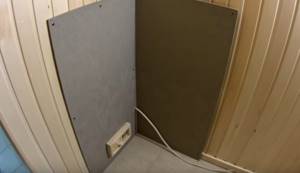
What else is good about fiber cement boards: they are cheaper than stainless steel sheets and splash marks are not visible on them.
Step 2 . Electricity supply. To connect three phases, a five-core cable is required. It is inserted into the device through a rubber gasket and securely fixed. After this, all the conductors are attached to the corresponding terminals: grounding, zero and three phases.
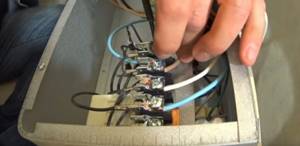
The cores are attached to the terminals
The electric furnace cover is installed.
Step 2 . Stove mounting. The electrical appliance must be placed at least 15 cm from the floor. You will need 6x80 mm self-tapping screws. Since the weight of the unit can be significant, it is recommended to additionally install a mortgage in the wall at the location of the fasteners (under the cladding). Markings are applied for installing hardware. Two self-tapping screws are screwed in, on which the stove will hang.

Self-tapping screws are tightened
The heater is suspended on a mount.
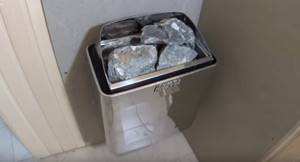
Hanging stove
Step 4 . Preparing for work. Carefully, trying not to damage the heating elements, the stones are laid. They must be washed and dried. It is recommended to choose narrow stones that fit freely between the spirals of the heating element. They are not laid close to each other; there should be a small distance between them so that hot air can escape freely.
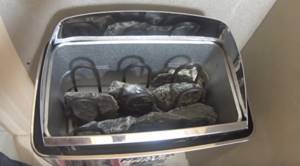
Laying stones
If you do come across large stones, it is better to lay them on top. The oven is ready for use.
Power calculation
It is easier to calculate the power of an electric stove than a wood stove. The manufacturer indicates the power in kilowatts in the passport. The consumer can only determine the volume of his steam room in order to get his bearings. But! There is a formal volume, and there is an adjusted volume after adding coefficients - for example, for surfaces without thermal insulation, for heating adjacent rooms in winter, etc.
So, tiles, glass, stone - you need to calculate their surface area, multiply by 1.2 and add to the formal volume.
the glass door to the steam room separately - just add an extra one and a half cubes to the existing numbers.
Then it’s simple: for one kilowatt of stove power - one cubic meter of steam room space, if the stove has heating elements , and one and a half cubic meters if there are tape heaters .
Manufacturers of electric furnaces for baths
In order not to lump everything into a heap, we have divided the manufacturers of electric stoves for baths into domestic and foreign ones. In cases where entire articles are devoted to groups or individual manufacturers, brief information is provided here.
Domestic electric heaters for baths
Among them, it is worth mentioning the company "Polytech", which produces various stoves under the general name "Christina", varying only the second part of the name. The advantages of its heaters include the relatively low cost and the presence of strip heaters, the advantages of which were discussed above.
There are other manufacturers of electric furnaces for baths who supply strip heaters - these are Ermak and Elektropech . In addition, they are found in Vesta ovens, the manufacturer of which remains unknown to us. In all cases the price is moderate .
For a more complete overview of the most popular Russian heaters, we recommend reading the article at the link provided.
Video on topic
A video that talks about two Christina stoves of different power:
Foreign electric heaters
People in Russia are most familiar with Finnish-made heaters. And they really are the majority among the products of foreign companies represented on our market.
In this regard, we devoted several articles to Finnish electric stoves: a review of different companies, which, by the way, included the Swedish Tylo, which recently merged with the Finns, as well as two articles about the most popular company in Russia, Harvia - a review of the stoves of this companies and an article to help those who want to know whether Harvia is suitable for their steam room.
Video on topic
Video about the range of electric furnaces ]SAWO[/anchor]:
In addition to the Finns, you can also find German-made electric furnaces on the market, in particular from EOS.
Electric heater EOS
A characteristic feature of EOS stoves is that the company does not rely on attractive appearance, believing that strength and reliability are attractive in themselves. Therefore, there are relatively few cheap stoves in their model range, and among the expensive ones you can find such a refinement of design thought as a mill wheel that supplies water to a red-hot metal pyramid. Well, everything here is for everyone.

Therefore, we will risk expressing our own opinion: if durability is important to the buyer, EOS electric furnaces are quite suitable for him, even in the angular design that is typical of most models. Everything else, in essence, doesn’t matter. By the way, strange-looking cylindrical models appeared at last year’s exhibitions - Zeus and Orbit, for example. But they still lack grace.
EOS electric heaters are available in floor-mounted, wall-mounted and under-counter versions . Power varies within average limits: from 2 to 12 kW. Some models are equipped with steam generators .
IMPORTANT! It is worth paying attention to the network requirements - there are models that require non-standard 400 volts.
Dimensions
The smaller the sauna, the more important the size of the stove becomes. Low-power heaters are usually very modest in size. As an example, we can mention the Harvia Compact stove - its width is 24.5-30 cm, depth 22 cm, height 54 cm. It weighs only 9 kg (without stones). Another model from the same company - Vega Compact - weighs even less: 7 kg and has dimensions: 28x29.5x50.5 cm.
IMPORTANT! Information on sizes is essential for selection, therefore it is always indicated in catalogs.
Yes, and one more interesting point : ovens of the same size (within the same line) can have different power. This allows the manufacturer to reduce production costs, and the consumer to choose a standard-sized heater for the volume of the steam room.
Further information will be useful to those who have already purchased a stove and need information on how to properly install and connect it.
For public or private use?
The question is important, so we have added a special filter to our stove catalog, dividing the list into stoves for private and public use. The difference is in the approach to model design. You will not find controls on public ovens. In addition, ovens for public use are specifically tested to ensure they will operate continuously. There are exceptions, for example, the IKI Pillar heater, which has such a wide range of models that there are models for an apartment sauna and giants for a commercial spa.
As a rule, the manufacturer gives different warranty periods if the stove is in private use or in a commercial facility.
Installing an electric stove in a sauna
Of course, an electric heater is not nearly as demanding as a wood-burning (and even more so a brick) stove. It does not need a foundation or a chimney ; many models can be mounted on the wall, and some can even be hung from the ceiling! However, some preparation is still necessary.
For your information! Did you know that some heater models can be installed directly into the bottom shelf? This significantly saves space, and the shelf is protected by a special flange made of steel or other material, which can be purchased along with the stove.

Where the heater will stand, it is better to lay out the floor with tiles or otherwise make it non-flammable (put a sheet of metal, for example). A suspended structure does not need this.
You will find the minimum distances to the main surfaces in the stove data sheet . Usually they are small, but they should be observed exactly or upward.
But if practically no questions arise regarding the installation of the furnace itself, then the same cannot be said about its connection.
How not to get burned?
Of course, if you touch hot stones or shadows, the result will be disastrous, but with cases it’s not so simple. Tylo stoves fare best. The Thermosafe flocked coating gives the stove a velvety feel and protects against heat.
Another approach to thermal insulation is Helo thermos stoves, such as Saunatonttu. The body of the thermos stove not only retains the heat inside, but also prevents you from getting burned on the outside.
It is also difficult to get burned on stoves finished with soapstone from Tulikivi. If the body is made of stainless steel, then you should think about a fence.
Connecting an electric stove in a sauna
The fact is that each sauna owner must independently take care of grounding the purchased unit. If you are not particularly versed in electrics, then entrust the connection to professionals , it is worth it.
It was already mentioned above that electric heaters come with different voltages. For those that can be connected to a regular network, nothing needs to be changed in the wiring. But for those with a voltage of 380, you already need to stretch a cable of the appropriate quality and thickness .
So, grounding. It is better to make its circuit separate for the sauna, rather than using the circuit of the distribution panel . It's not that difficult - the Internet is full of information on how to make a ground loop yourself. It is preferable to conduct the core through cable channels.
In addition, we can recommend connecting the stove to the network not directly, but through a device that ensures that the electrical appliance is turned off if a short circuit occurs or the air in the steam room gets too hot. Such a device will not be needed if a differential circuit breaker with a leakage current of 30 mA is installed.
Most models provide a choice of a built-in or remote control panel. In the second case, you will have to take care of connecting the remote control. Typically, owners place it either at the door or in an adjacent room.
IMPORTANT! The remote control needs a circuit breaker in the distribution panel. Look at the stove data sheet to find out the current load. In accordance with it, the denomination of the machine is selected.
Electric furnace sensors allow you to monitor and control the heat. They also require installation, but all its points must be described in detail in the installation instructions for your stove.
IMPORTANT! Do not use intermediate connections, or extend or twist sensor wires.
A separate question is what wires can be used to connect the electric heater. If the oven is designed for 220 volts, then the wires will be three-wire, if for 380 - five-wire. An important issue is the sheath of such wires. The fact is that vinyl is in no way suitable for your purposes. It is correct to use rubber-insulated wiring that is not afraid of high temperatures.
*** So, we will consider that the short course for the future owner of an electric heater is completed. I wish you health and a pleasant stay in your own sauna!
Rules for installing electric sauna stoves

Requirements SNiP 41-01-2003
This document regulates the basic rules for placing electric furnaces from a fire safety point of view:
- The stove must be installed in a corner closer to the entrance, however, subject to the requirements of SNiP, installation in the center of the room is also allowed.
- The floor where the stove is installed is covered with non-combustible materials.
- The distance between the wall and the furnace body must be at least 0.5 meters in the absence of a screen. If such protection is installed, it is allowed to place the electric oven closer.
- There should be a hole in the area of the heater for fresh ventilation.
- The furnace body must be protected by a fence located at a distance of at least 70 cm.
.

How to install the housing and controls?
The first step is to wash and dry the stones, place them and turn on the stove. When connecting an empty stove, the heating elements will burn out. When installing the control panel, the following requirements must be met:
- The external remote control is installed in a room where there are no elevated temperatures.
- The wiring is done in advance.
- The power that the electrical panel and wires can withstand must not be lower than the power of the electric furnace.
- The presence of an RCD is required.
- In order to avoid contact between wires and heated walls, they are laid in a special bus made of fireproof material.
Installation of sensors and grounding
It is recommended to use only cables made of heat-resistant material. The presence of twists is excluded; all wire sections must be intact. Sensors are usually mounted above the door, heater and steam benches.
GOST 12.1.030-81 requirements and electrical wiring cross-section
According to GOST 12.1.030-81, the electrical circuit must be grounded directly or grounded through the shield. As mentioned above, the power that the wiring can withstand must be higher than the power of the furnace itself. The selection of conductor cross-sections is made according to special tables.
.
